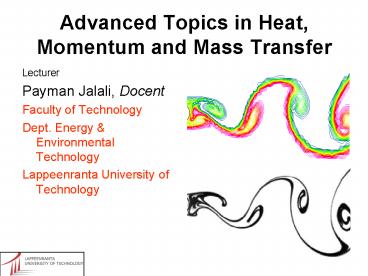Advanced Topics in Heat, Momentum and Mass Transfer - PowerPoint PPT Presentation
1 / 11
Title:
Advanced Topics in Heat, Momentum and Mass Transfer
Description:
2) The second step is the discretization of the partial differential equation, ... One is called the Crank-Nicolson scheme in which: (I) (II) (I), (II) ... – PowerPoint PPT presentation
Number of Views:616
Avg rating:3.0/5.0
Title: Advanced Topics in Heat, Momentum and Mass Transfer
1
Advanced Topics in Heat, Momentum and Mass
Transfer
- Lecturer
- Payman Jalali, Docent
- Faculty of Technology
- Dept. Energy Environmental Technology
- Lappeenranta University of Technology
2
- Outline of the lecture
- In this lecture, three major steps in any CFD
simulation will be introduced - The concept of discretization a) domain b)
governing equations - How is the partial differential equation (PDE)
of transient diffusion equation discretized and
transferred into algebraic system of equations
(matrix form)? - How are boundary and initial conditions handled
in the system of algebraic equations?
3
- The concept of discretization
- Domain The first concept in CFD is the
discontinuity of solution. It means that CFD
cannot give us continuous solution to the
governing partial differential equations of the
fluid flow or the heat transfer. Therefore, the
domain discretization (or mesh generation) is to
create discrete points (or elements) on which
solution will be determined. Some examples are
shown below
4
The concept of discretization b) Governing
equations As a result of domain discretization
the governing equations cannot be in the form of
partial derivatives. Therefore, we have to
approximate them in algebraic form which
expresses the governing equations for the nodes
or the elements of solution domain. In
finite-difference (FD) schemes, it is done using
the Taylor expansion of derivatives. For example,
5
- Implementation How can the partial differential
equation (PDE) of transient diffusion equation be
discretized and transferred into algebraic system
of equations (matrix form)? - Transient diffusion from a source to
semi-infinite medium.
1) The first step is domain discretization, which
is 1D domain.
6
2) The second step is the discretization of the
partial differential equation, which is the
transient diffusion equation. Using
We substitute the second derivative in the
diffusion equation where it is discretized at an
arbitrary point i at time step m
For the time derivative, we can use different
numerical schemes. One is called the
Crank-Nicolson scheme in which
7
(I),
(II)
m represents current time step and m1 is the
next time step that we are going to calculate.
When m0 it refers to the initial condition in
which the value of c is known and it is used to
calculate the first time step. Then the second
time step will use the results of the first time
step and so on. In this expression, we arrange
the terms corresponding to next and current time
steps in the left and right hand side of
equation, respectively. (Practice Combine Eqs. I
and II and derive Eq. III)
This equation is a finite-difference equation
(FDE) in which any value of concentration at a
node i in a time step m1 (next time step) is
related to those of the nodes in the time step m
(current time step).
8
3) The third step is applying boundary and
initial conditions. Notice that initial
conditions correspond to the zero time step (m0)
and boundary conditions to the bounding nodes
(i1,N).
Boundary conditions for the FDE is written as
follows
9
- Note that in most numerical methods we can not
have the boundaries at infinity. We have to
consider a finite point for our domain located at
a physical infinite point. Therefore, our results
may have another error because of this truncation
of infinite boundary. - By imposing boundary conditions in FDE, the
matrix form of the system of equations will be
obtained. Starting with i2, we have
Similar equations will be obtained by changing
the value of i to the last value, N-1. For iN-1
10
The matrix form of FDEs will be as follows
11
Concentration vector at the right hand side is
the current concentration vector which is
determined by the initial condition at the first
time step (m0), and at each time step, it will
be the result of the previous time
step. Homework Write down FDE equations on
paper for the first 2 time steps (m1,2) when
there are only 5 nodes (N5). Take D1 m2/s,
?t0.01s, c01, c?0.































